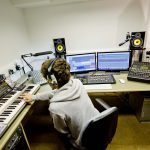
On the BA (Hons) Electronic Music & Sound you are encouraged to fully explore your creativity in a practice-based course focusing on experimentation and innovation. The course provides an excellent foundation for careers in musical composition and sound design for film, TV and video, the games industry, radio, theatre and performing arts, interactive and new media, and sound arts for galleries and public spaces.
The course places you at the forefront of modern practice in the sound and music world, an environment where technologies are constantly evolving. You will be encouraged to engage creatively and critically with the way sound and music is represented in current media and artwork, in the heart of a city renowned for its arts and cultural scene.
Guided by the research active and experienced staff team, you will explore the use of music and sound in a wide diversity of aesthetic forms and across a broad range of technological media, laying particular stress on the relationship between music and sound and other art forms – and on the exploration of innovative and hybrid sound concepts in both the arts and the creative industries.
Profile areas and Pathways
Electronic Music and Sound is the perfect learning environment for students with backgrounds in music technology, sound and moving image, creative audio production for a variety of media as well as mature students of varied backgrounds with a portfolio that demonstrates a strong interest in sound and music. The course offers three main areas of study:
1) Electronic Music & Creative Sound Production: covering sound and music in the context of contemporary innovative digital music production, including sound for mobile media, music interface design, generative composition and immersive audio environments.
2) Sound for the Moving Image: addressing screen based sound (sound design and composition) work for film, video, TV, the web and video games.
3) Sound Art: addressing sound in relation to other art forms, such as sculpture, installation art, photography, architecture, performance art, environmental art and radiophonics.
FACILITIES
The course is based in the University of Brighton’s city campus in Grand Parade. Our facilities can be accessed through the east wing of the campus. Our students can access our facilities from 8am-8pm every day. Our facilities include:
- Four modern digital production and post-production studios equipped with state of-the-art hardware and software.
- Two sound-isolated recording booths
- A sound diffusion lab where students can experiment with spatial projection, multichannel sound and unconventional speaker configurations
- Workstation area for individual student use, teaching presentations and demonstrations that is equipped with all taught software
- Dedicated tutorial room for individual and small group consultations
- Separate workshop area where students build customised instruments and devices.
- Access to a large multipurpose ‘Performance Studio’ used for lectures, workshops, installations, screenings and rehearsals.
Software used in the course: Logic Studio Pro, Ableton Live, Pro Tools, Max/MSP, Pure Data and various other open source applications. Students will be able to experiment with software and hardware design, enabling them to build their own acoustic, electric or virtual instruments and installations.










